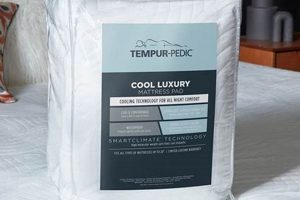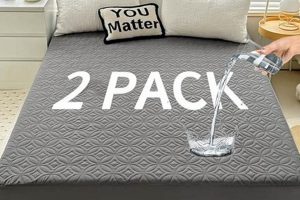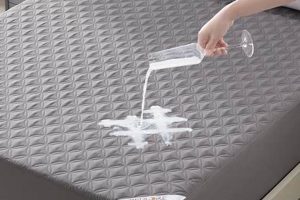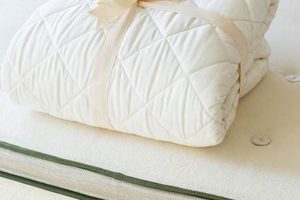A specialized bedding accessory designed for use with Tempur-Pedic mattresses, this item serves as a protective barrier. It typically consists of a fitted sheet style encasement made from materials that are waterproof, breathable, or both. Its primary function is to shield the mattress from spills, stains, dust mites, allergens, and other potential damage that can shorten its lifespan or compromise its cleanliness.
Using such a protector extends the life of the mattress, maintaining its integrity and hygiene over time. It provides a cost-effective solution by preventing the need for frequent mattress replacements. Furthermore, it helps maintain the mattress warranty, as many warranties are voided by stains or damage that could have been prevented by a protective cover. It is crucial for those with allergies or sensitivities, creating a healthier sleeping environment. Historically, mattress protection has evolved from simple fabric covers to technologically advanced materials designed to offer superior protection and comfort.
The subsequent discussion will delve into the various types of these protectors, their key features, factors to consider when selecting one, proper care and maintenance procedures, and a comparison with alternative mattress protection options available on the market. This detailed analysis aims to provide a thorough understanding of the role and value of this accessory within a comprehensive sleep system.
Essential Considerations for Mattress Protection
Proper selection and maintenance are crucial for maximizing the lifespan and effectiveness of a mattress encasement. The following points outline essential considerations.
Tip 1: Evaluate Material Composition: Prioritize breathable materials, such as cotton or bamboo, to prevent overheating and maintain a comfortable sleep temperature. Avoid purely synthetic materials that may trap heat and moisture.
Tip 2: Assess Waterproofing Technology: Ensure the waterproofing membrane is effective yet breathable. Look for protectors utilizing polyurethane or TPU membranes, known for their waterproof capabilities without compromising airflow.
Tip 3: Confirm Allergen and Dust Mite Resistance: Choose protectors specifically designed to create a barrier against allergens and dust mites. Tightly woven fabrics are essential to prevent penetration.
Tip 4: Verify Secure Fit: Select a protector with deep pockets and a secure elastic band to ensure a snug fit that prevents shifting and bunching during sleep. An ill-fitting protector compromises effectiveness.
Tip 5: Implement Regular Cleaning: Adhere strictly to the manufacturer’s washing instructions. Regular cleaning, typically every one to two months, prevents the buildup of allergens and maintains hygiene.
Tip 6: Inspect for Damage: Routinely inspect the protector for tears, punctures, or seam weaknesses. Promptly repair or replace damaged protectors to maintain optimal performance.
Tip 7: Consider Noise Reduction: Some waterproof membranes can generate noise. Prioritize protectors described as “quiet” or those utilizing fabric-backed membranes to minimize sleep disruption.
Adhering to these guidelines ensures the ongoing efficacy and longevity of mattress protection. These practices contribute to a cleaner, healthier sleep environment and preserve the investment in high-quality sleep surfaces.
The final section will summarize the key elements of selecting and maintaining mattress protection, emphasizing its integral role in a comprehensive sleep system.
1. Waterproof Barrier
The presence of a waterproof barrier is a primary differentiator and critical feature within a Tempur-Pedic mattress protector. Its function is to prevent liquids, including spills, sweat, and bodily fluids, from penetrating the mattress core. This barrier shields the visco-elastic foam from irreversible damage and staining. For example, a single incident involving a spilled beverage can lead to mold growth within the mattress, compromising its structural integrity and hygiene. The waterproof barrier mitigates this risk.
The effectiveness of the waterproof barrier relies on its composition and construction. Typically, a thin membrane, often made of polyurethane or thermoplastic polyurethane (TPU), is laminated to the fabric surface of the protector. This membrane must be impermeable to liquids while ideally allowing for some degree of breathability to prevent moisture buildup and maintain a comfortable sleep environment. In practice, cheaper, less breathable waterproof barriers can trap heat and lead to discomfort, negating some of the benefits of the mattress itself.
Therefore, understanding the properties and construction of the waterproof barrier is essential when selecting a Tempur-Pedic mattress protector. The key lies in balancing effective liquid protection with adequate breathability and comfort. The long-term integrity of the mattress depends on the reliable functioning of this barrier, and choosing a protector with a proven track record of performance is a sound investment. Its value should be measured by not only short-term spill protection but by long-term hygiene and mattress longevity.
2. Breathable Materials
The integration of breathable materials in a Tempur-Pedic mattress protector is not merely a comfort enhancement; it is a critical design element influencing the core functionality of the mattress system. Memory foam, the primary component of Tempur-Pedic mattresses, is known for its heat retention properties. The presence of a non-breathable protector exacerbates this issue, leading to elevated sleep surface temperatures and potential discomfort. In contrast, protectors constructed from breathable materials such as cotton, bamboo rayon, or advanced synthetic blends facilitate air circulation, mitigating heat buildup and promoting a cooler, more regulated sleep environment. This effect is not simply anecdotal; studies have shown a direct correlation between breathable bedding materials and improved sleep quality, particularly for individuals susceptible to night sweats or living in warmer climates.
The choice of breathable materials also extends to the waterproof membrane incorporated within the protector. Traditional waterproof membranes, often made of solid polyurethane, can impede airflow significantly. Modern designs employ microporous membranes or breathable films that allow water vapor to escape while preventing liquid penetration. This technology is particularly important in maintaining the integrity of the Tempur-Pedic mattress, as trapped moisture can degrade the foam over time, fostering mold growth and reducing its conforming properties. For example, a protector utilizing a TPU (thermoplastic polyurethane) membrane allows for enhanced breathability compared to traditional polyurethane, minimizing moisture retention and ensuring a more hygienic sleeping surface.
In summary, the strategic selection of breathable materials in a Tempur-Pedic mattress protector serves to counteract the inherent heat retention properties of memory foam, promote a more comfortable sleep temperature, and maintain the long-term structural integrity and hygiene of the mattress. The effectiveness of the waterproof barrier must be balanced with the need for breathability to achieve optimal performance and user satisfaction. Failure to prioritize breathable materials can negate the benefits of the Tempur-Pedic mattress itself, resulting in a less comfortable and potentially less durable sleep environment.
3. Allergen Protection
The connection between allergen protection and a Tempur-Pedic mattress protector is direct and significant. Mattresses, including those made of memory foam, are susceptible to harboring allergens such as dust mites, pet dander, mold spores, and pollen. These allergens accumulate within the mattress fibers over time, potentially triggering allergic reactions and respiratory issues in sensitive individuals. A Tempur-Pedic mattress protector designed with allergen protection acts as a barrier, preventing these allergens from penetrating the mattress core. The effectiveness of this barrier directly influences the indoor air quality within the sleeping environment and subsequently, the health and well-being of the mattress user. For instance, individuals with asthma may experience exacerbated symptoms if exposed to high concentrations of dust mites in their bedding. A properly designed mattress protector mitigates this risk.
The mechanism by which a mattress protector provides allergen protection typically involves tightly woven fabric with small pore sizes. These fabrics physically prevent dust mites and other allergens from passing through and reaching the mattress. Some protectors are also treated with antimicrobial agents to inhibit the growth of mold and bacteria, further reducing the allergen load. The practical application of this understanding is evident in the selection of mattress protectors specifically certified as “allergy-friendly” by independent organizations. These certifications indicate that the protector has undergone rigorous testing to demonstrate its ability to block allergens effectively. Furthermore, regular washing of the mattress protector, as recommended by the manufacturer, is crucial for maintaining its allergen-blocking properties.
In summary, the allergen protection offered by a Tempur-Pedic mattress protector is an essential component of a healthy sleep environment. By creating a physical barrier against allergens and inhibiting microbial growth, the protector minimizes the risk of allergic reactions and respiratory issues. Selecting a protector certified for allergen protection and adhering to regular washing protocols are key strategies for maximizing its effectiveness. Failure to prioritize allergen protection can compromise the health benefits associated with a high-quality mattress, potentially leading to adverse health outcomes for sensitive individuals.
4. Secure Fit
The term “Secure Fit” carries significant weight when evaluating a Tempur-Pedic mattress protector. It refers to the protector’s ability to remain snugly and consistently in place on the mattress, ensuring uninterrupted performance and protection. A poorly fitting protector can bunch, shift, or detach, compromising its ability to safeguard the mattress from spills, allergens, and wear. The following facets detail the crucial elements of a secure fit.
- Deep Pocket Design
A deep pocket design accommodates the thickness of Tempur-Pedic mattresses, which often exceed standard mattress depths. Insufficient pocket depth results in stretching and potential tearing of the protector, and increased likelihood of slippage. For instance, a mattress protector advertised as having a 15-inch pocket may prove inadequate for a 14-inch mattress, leading to compromised edge protection and overall instability.
- Elastic Perimeter Band
An elastic perimeter band provides a secure grip around the mattress edges, preventing the protector from shifting during sleep. The quality and strength of the elastic are critical. A weak or stretched-out band will fail to maintain tension, allowing the protector to bunch or come loose. Consider a scenario where constant tossing and turning causes a protector with a weak elastic band to detach from a corner, exposing that area of the mattress to potential damage.
- Fitted Sheet Style Construction
A fitted sheet style construction, as opposed to a simpler encasement, ensures a more tailored and secure fit. The tailored design conforms to the contours of the mattress, minimizing excess fabric that could contribute to bunching or shifting. An ill-fitting encasement can create pressure points or alter the feel of the mattress, detracting from the benefits of the Tempur-Pedic material.
- Material Composition and Stretch
The material composition and inherent stretch of the protector fabric influence its ability to conform to the mattress and maintain a secure fit. Fabrics with inadequate stretch may feel rigid and uncomfortable, while overly stretchy materials can lose their shape and become prone to slippage. A balance between durability and flexibility is crucial. For example, a protector constructed from a tightly woven, slightly elastic blend will offer both protection and a secure fit without compromising comfort.
The factors described above are inextricably linked in delivering a “Secure Fit.” Prioritizing these elements when selecting a Tempur-Pedic mattress protector ensures continuous, reliable protection and preserves the integrity and comfort of the mattress. The absence of a secure fit undermines the intended purpose of the protector, exposing the mattress to damage and reducing its lifespan.
5. Easy Cleaning
The characteristic of “Easy Cleaning” holds substantial importance in the selection and maintenance of a Tempur-Pedic mattress protector. Its relevance lies in the direct impact on hygiene, allergen control, and the long-term preservation of both the protector and the underlying mattress. Failure to maintain cleanliness compromises the protector’s intended function and can lead to health and warranty implications.
- Machine Washability
Machine washability constitutes a fundamental aspect of easy cleaning. Protectors designed for machine washing facilitate regular and convenient maintenance. The ability to launder the protector in a standard washing machine eliminates the need for specialized cleaning services or cumbersome hand-washing procedures. For instance, a protector that requires dry cleaning presents a significant impediment to routine cleaning, leading to potential neglect and a buildup of allergens and contaminants. In contrast, a machine-washable protector enables frequent laundering, promoting optimal hygiene and allergen control.
- Stain Resistance
The incorporation of stain-resistant materials or treatments enhances the ease of cleaning. Stain resistance minimizes the absorption of spills and bodily fluids, preventing permanent discoloration and simplifying the removal of stains. For example, a protector with a water-repellent finish allows spills to be easily blotted away before they penetrate the fabric, reducing the need for aggressive cleaning agents or prolonged soaking. This attribute directly contributes to the protector’s aesthetic appeal and functional lifespan.
- Quick Drying
Rapid drying capabilities further simplify the cleaning process. Protectors that dry quickly after washing reduce the risk of mold and mildew growth, particularly in humid environments. A protector that requires an extended drying time may promote the proliferation of microorganisms, compromising hygiene and potentially emitting unpleasant odors. The quick-drying feature also minimizes the disruption to bedding arrangements, allowing for prompt replacement of the protector after laundering.
- Durable Construction
A durable construction capable of withstanding repeated washings is essential for maintaining the protector’s integrity and performance. Protectors constructed from flimsy materials or with poorly reinforced seams may deteriorate rapidly with each wash cycle, compromising their protective qualities. For example, a protector with a delaminating waterproof membrane or unraveling seams will fail to provide adequate protection against spills and allergens. A durable construction ensures that the protector retains its shape, fit, and protective properties over an extended period, maximizing its value and lifespan.
These interwoven facets underscore the pivotal role of easy cleaning in preserving the effectiveness and longevity of a Tempur-Pedic mattress protector. The attributes of machine washability, stain resistance, quick drying, and durable construction collectively facilitate routine maintenance, promote optimal hygiene, and contribute to the long-term preservation of both the protector and the underlying mattress. A failure to prioritize easy cleaning can negate the benefits of the protector and potentially compromise the health and hygiene of the sleep environment.
6. Warranty Preservation
Warranty preservation is intrinsically linked to the use of a Tempur-Pedic mattress protector. The manufacturer’s warranty typically stipulates conditions under which the warranty may be voided, and damage caused by spills, stains, or unsanitary conditions are commonly cited as reasons for invalidation. A mattress protector serves as a preventative measure, mitigating the risk of such damage and ensuring the continued validity of the warranty.
- Protection Against Stains and Spills
The primary function of a mattress protector is to shield the mattress from stains and spills, which are frequently cited as grounds for warranty voidance. Penetration of liquids into the mattress core can lead to irreversible damage, mold growth, and compromised hygiene. A waterproof mattress protector creates a barrier, preventing liquids from reaching the mattress and preserving its condition. For example, the warranty on a Tempur-Pedic mattress may be voided if a coffee spill results in permanent staining, but a properly functioning protector would prevent the spill from ever reaching the mattress material.
- Prevention of Unsanitary Conditions
Mattress protectors help maintain sanitary conditions by preventing the accumulation of dust mites, allergens, and other contaminants within the mattress fibers. Unsanitary conditions can not only void the warranty but also compromise the health and well-being of the mattress user. A mattress protector with hypoallergenic properties creates a barrier against these contaminants, keeping the mattress clean and sanitary. The presence of mold, for example, due to lack of protection can void many mattress warranties.
- Documentation of Protection
Maintaining proof of purchase for both the mattress and the protector can be crucial in the event of a warranty claim. In some cases, manufacturers may require evidence that a mattress protector was used to demonstrate that reasonable steps were taken to protect the mattress. Keeping records of these purchases can strengthen a warranty claim and ensure that it is processed smoothly. For instance, presenting receipts for both the Tempur-Pedic mattress and the associated protector can serve as evidence of proactive mattress care.
- Adherence to Care Instructions
Following the manufacturer’s care instructions for both the mattress and the protector is essential for warranty preservation. Using inappropriate cleaning methods or failing to properly maintain the protector can void the warranty. Adhering to the recommended washing and care guidelines ensures that the protector continues to function effectively and that the mattress remains protected. Ignoring cleaning guidelines, such as using harsh chemicals, could damage the protector and, consequently, jeopardize the mattress warranty.
These facets highlight the significant role a Tempur-Pedic mattress protector plays in upholding the mattress warranty. By providing a physical barrier against stains, spills, and unsanitary conditions, documenting the use of a protector, and adhering to care instructions, consumers can maximize the lifespan of their mattress and ensure that the warranty remains valid. The investment in a quality mattress protector is therefore not only a safeguard for the mattress but also a means of protecting the consumer’s investment and rights under the warranty.
Frequently Asked Questions
The following questions address common inquiries regarding the selection, use, and maintenance of mattress protection designed for Tempur-Pedic mattresses.
Question 1: What constitutes a suitable material for a Tempur-Pedic mattress protector, given the memory foam’s temperature sensitivity?
Optimal materials possess both waterproof qualities and breathability. Natural fibers, such as cotton or bamboo, or advanced synthetic blends with moisture-wicking properties, are preferred. These materials mitigate heat retention associated with memory foam while safeguarding against spills and stains. Avoid purely synthetic, non-breathable materials that can exacerbate heat buildup.
Question 2: How frequently should a Tempur-Pedic mattress protector be laundered?
The recommended laundering frequency is every one to two months under normal usage conditions. More frequent washing may be necessary in cases of spills, accidents, or for individuals with allergies. Always adhere to the manufacturer’s specific washing instructions to prevent damage to the protector’s waterproof membrane or other features.
Question 3: Does the use of a mattress protector alter the feel or performance of a Tempur-Pedic mattress?
A well-designed mattress protector should minimally impact the feel of the mattress. Thin, flexible materials and a secure fit are crucial. Avoid thick or heavily padded protectors that may diminish the conforming properties of the memory foam. The selection should prioritize protectors specifically designed to complement memory foam mattresses.
Question 4: How does a mattress protector contribute to allergy management?
A mattress protector acts as a barrier against dust mites, pet dander, and other allergens that accumulate within mattresses. Select protectors with tightly woven fabrics or hypoallergenic treatments to effectively block allergens. Regular laundering further reduces allergen buildup and promotes a cleaner sleeping environment.
Question 5: What features indicate a high-quality waterproof membrane in a mattress protector?
Look for membranes constructed from polyurethane (PU) or thermoplastic polyurethane (TPU). These materials offer effective waterproofing while allowing for some degree of breathability. Avoid protectors with vinyl membranes, as they are typically less breathable and can generate noise. Certifications from reputable testing organizations can also validate the waterproof performance of the membrane.
Question 6: Is the use of a mattress protector essential for maintaining a Tempur-Pedic mattress warranty?
While not always explicitly mandated, using a mattress protector is highly recommended for warranty preservation. Stains, spills, and unsanitary conditions can void the warranty. A protector mitigates the risk of such damage, providing a proactive defense against warranty-compromising incidents. Maintaining records of both the mattress and protector purchases can also be beneficial in the event of a warranty claim.
Proper mattress protection is a key element in maintaining a clean, hygienic, and comfortable sleep environment, while also safeguarding the warranty of the Tempur-Pedic mattress.
The following section will provide specific product recommendations and reviews, based on the criteria discussed herein.
Conclusion
The preceding analysis has detailed the multifaceted importance of a Tempur-Pedic mattress protector. Its role extends beyond simple surface covering, encompassing critical functions related to hygiene, comfort, mattress longevity, and warranty preservation. The protector’s composition, construction, and maintenance are all vital considerations in maximizing its effectiveness. Breathable materials, a secure fit, ease of cleaning, and a reliable waterproof barrier are essential attributes.
Given the investment in a premium sleep surface like a Tempur-Pedic mattress, the selection of an appropriate protector should not be treated as an afterthought. It represents a proactive measure to safeguard that investment and ensure a consistent, hygienic sleep environment for years to come. Careful consideration of the aforementioned factors will contribute to a sound decision that ultimately benefits both the mattress and the user’s overall well-being.







